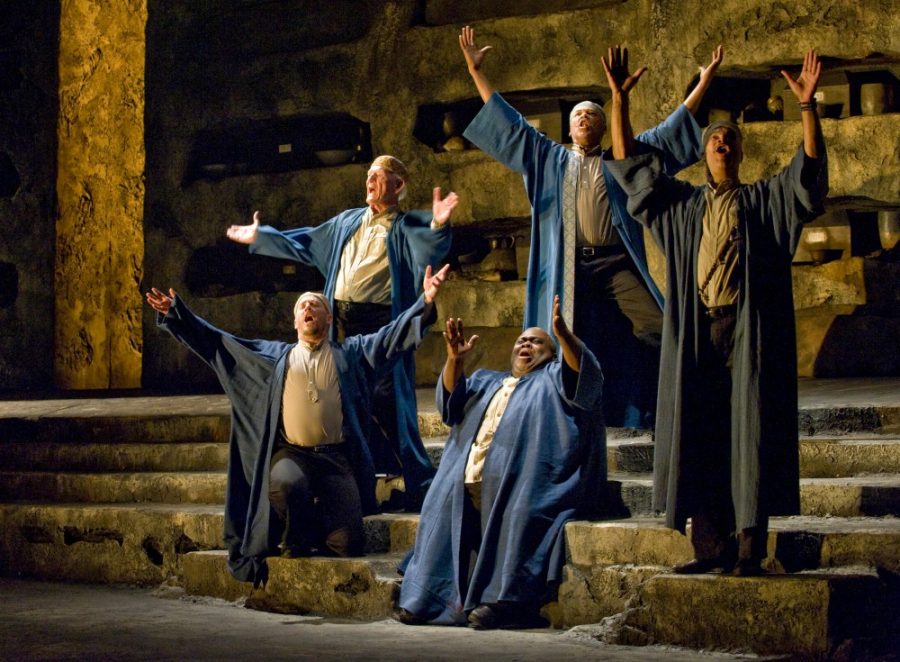Directed By: Marcela Lorca
Starring: Sun Mee Chomet, Stephen Yoakam, Prentiss Standridge
Written by: Seamus Heaney
Where: Guthrie Theater, 818 S. Second St.
When: Until Nov. 6, times vary
Cost: $24 – $62
Run time: 90 minutes, no intermission
The McGuire Proscenium stage has been transformed into an austere and dimly-lit stone catacomb. This somber locale sets the tone for the solemn philosophical questions asked in âÄúThe Burial at Thebes.âÄù
The inevitable outcome to this contemporary reading of SophoclesâÄô âÄúAntigoneâÄù makes the rest of the show feel like an extended funeral march. The title alone hints at the conclusion to this dismal tale of one woman who fought the law. Of course, even for Antigone, the lyrics won’t change.
In her production of Irish Nobel Prize winner Seamus HeaneyâÄôs script, director Marcela Lorca serves the tale on a platter with modern flavor and gospel- and R&B-inspired musical interludes.
When AntigoneâÄôs brother Polyneices dies in a battle against his native Thebes, King Creon rules that he is not to be dignified with a proper burial. When Antigone, ever the iconoclast, defies this dictate with an attempt to bury her brother, Creon condemns her to die.
It is in this conflict of personal principle against state rule that the play draws its strength. At times, Creon seems like nothing but a stubborn leader. The state is embodied in one man and dictated by his whims.
The highlights of âÄúBurialâÄù are in the fourth wall-shattering vocals that bellow forth from the majestic corpus of chorus member Robert Robinson. His voice fills the auditorium, and substantiates the creative decision to include a few too many musical numbers.
After our protagonist, her lover and his mother have dropped like flies, the audience is treated to an appearance of Tiresias. The show-stopping monologue by the blind prophet (Greta Oglesby), that ever-loving hermaphroditic conduit of fate, serves to inspire regret in King Creon for his grave and hubristic misdeeds.
âÄúBurialâÄù has blemishes, however, which pose minor distractions and disrupt the play’s ability to lull the audience into its world. As minimal as the set already was, considering its roots, it could have done without the smoke machine that intermittently puffs throughout the play.
Costume choices, though inventive, proved vexing and called attention away from the action. King Creon’s costume, a tailored military uniform overlaid by a floor-length, black sleeveless cloak, is less the vestment of a stern monarch than something a villain from Star Trek would wear if he shopped at Hot Topic.
CreonâÄôs soldiers donned military fatigues âÄî a choice that gave a nod toward the workâÄôs contemporary social critique but was needlessly contrasted by the Grecian style gown worn by CreonâÄôs wife, Eurydice.
Unfortunately, Antigone’s near-incessant anguished cries can feel like the verbal beatings of a dead horse. She openly welcomes death in words, yet her tone suggests otherwise. âÄúThe lady doth protest too much,âÄù as the old saying goes.
Heaney’s savvy script has moved the dialogue, and thus our attention, to the king and his council of elders who hold our tragic heroine’s fate in their withered hands. There is little need to express, even further, how much tragedy is truly rife in this story. The reworked title provides a cue to the audience that the narrative of the Greek classic has shifted its focus.
Heaney’s perceptive and impassioned script offers Lorca a wealth of material with which to point its proverbial finger back at the audience. On most occasions, Lorca and her cast take advantage of these opportunities. In others, the stylized presentation of the material threatened to overshadow it.








